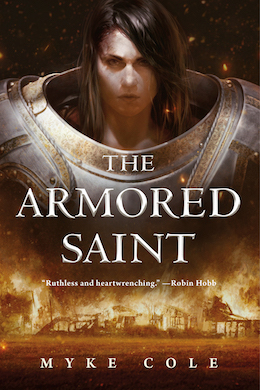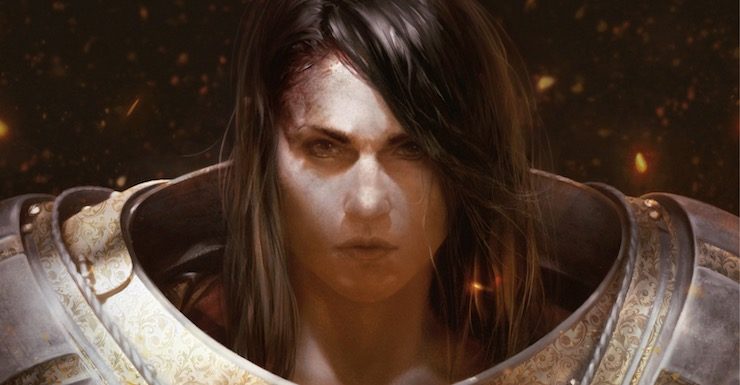The hoofbeats seemed to continue endlessly. The sound of the chains rose as they drew closer. Heloise could see the links playing out behind the horses, dragging in the dirt. A dead woman slid past Heloise, green and bloated, caked with road filth. She was wrapped in the long, gray ropes of her innards, tangled in the metal links until Heloise couldn’t tell her guts from the chains. The horses dragged another body beside her, wrapped in metal like a silkworm in molt.
Heloise’s gorge rose at the stink and she gagged, clapping a hand to her mouth. Another moment and they would be past. Please don’t notice us. Please ride on.
The jangling ceased as the riders halted. (Ch. 1)
From its opening pages, it’s clear that The Armored Saint isn’t messing around. The first volume in Myke Cole’s new epic fantasy series, it’s the gut-punching story of Heloise Factor and the village that raised her. It’s about rebellion, first love, and faith. The Armored Saint has all the hallmarks of epic fantasy—a secondary world overseen by a brutal religious order, magic, wizards, and devils—but it’s unusually slim, clocking in at around 200 pages. Cole makes good use of that space, however, and delivers a book that’s sleek, yet packed full of effective world building, intricate characters, and some truly satisfying SFnal elements.
Buy the Book


The Armored Saint
The Armored Saint is a story of duality. For every major facet, Cole juxtaposes its opposite. Heloise begins the story as a child, but is violently thrust into adulthood. Her relationship with Basina, the village tinker’s daughter, straddles an infinitely complex line between platonic friendship and romantic desire. An early conversation between Heloise and Basina explores the complicated duality of bravery and fear:
“I’m not brave,” Heloise said. “I’m frightened.”
“You were very brave back there with the Pilgrim,” Basina said. “You protected me.”
Heloise surprised herself by laughing. “I’ve never been so frightened in my life.”
Basina flashed her a smile. “Father says being brave isn’t not being frightened, it’s doing a thing even though you are.” (Ch. 4)
Even magic in The Armored Saint balances on a knife’s edge, a constantly shifting balance between perception and reality. Throughout The Armored Saint, alongside Heloise, we’re told of the danger that magic poses to humanity. Magic exposes wizards to Hell, it’s said, becoming a conduit for the Devils who live there. Heloise was being raised in a backwater village with no exposure to the world outside, and lives in fear of the Order, a militant government group who viciously hunt wizards. Despite everything she’s been taught about self-preservation, she harbours doubts about the Order’s methods. She rejects their cruelty and their mission. Her friend Clodio, a ranger and trader, offers her a glimpse of the outside world—a world of magic and possibility, of truths that the Order would crush.
This intricate dance between truth and faith is central to both The Armored Saint’s plot and its thematic core. As Heloise becomes more deeply intwined in the Order’s crusade against magic, she learns things about herself and the world that before seemed impossible. In doing so, she reveals herself to be a complex and powerful protagonist.
Heloise watched it turn end over end, the lid flapping open, the remaining papers threatening to fall out. She could see the wind plucking at them, ready to cast them down to join their comrades in the ruinous mud. She felt herself start to cry then, because it was the rest of what they had, because she knew that most of their earnings for the next season would have to go to replenish their supply, because… (Ch. 1)
In many ways, she is delicate and naïve, a sheltered villager, kept ignorant and cowed by an government that rules through violence and fear. This honest, almost poetic, delicacy helps Heloise to stand out in a down-in-the-mud world. But it isn’t a fragile or breakable delicacy—rather, it’s strong and resilient, able to lift tremendous weights, like spider silk. It also gives tremendous weight to her eventual rebellion and heroics. We believe in her as a hero because we already believe in her non-heroic facets.
She heard a dull thud, felt something soft strike her hands.
Her father’s eyes widened and the remains of the Sojourner’s smile vanished.
Heloise looked down at the satchel nestled in her outstretched arms. She had moved. She had caught it. “I’m sorry…” Her lips felt numb. She didn’t know why she’d done it. It was as if her body had been unable to accept the outcome, not when it could do something about it. “I didn’t mean…” (Ch. 1)
In a world that requires its people to be either ruthless or submissive, Heloise is neither. She is compassionate, but also angry and rebellious. She funnels her despair into action.
The fear and humiliation swirled in her mind and her gut, so intense that she almost missed a third, stronger emotion, boiling beneath it all.
Rage. Fury at the Order for making her father grovel while they destroyed the tools of his trade. (Ch.1 )
Heloise’s path through The Armored Saint is typical of a hero’s journey, but it also feels like a prelude to something larger—a question, rather than an answer. Because of Heloise’s isolation, The Armored Saint focuses on her personal conflicts, but there are hints of a wider and even more complex world. A slim novel, The Armored Saint is over almost before it begins, and I was left wanting more. There’s enormous opportunity for Cole to expand the series’ scope and complexity as Heloise is introduced to the larger world and its conflicts.
Central to that, and the novel’s most interesting and defining feature outside of its emotional complexity, are the war-engines—enormous seethestone-powered battle suits reminiscent of the Power Armor worn by soldiers in the Warhammer 40K universe. “A man inside one of these,” says a tinker who creates the war-engines, “is as fast as a hound with a scent, as strong as an army, as invulnerable as the sainted Palantines themselves.” The war-engines represents a taste of the larger world (they’re employed by the Emperor’s armies), a satisfying SFnal element that elevates the intensity of the novel’s bonebreaking climax, and also a source of power and hope for Heloise. The war-engines provide Heloise with the physical strength to match her courage and anger.
Cole has a visceral and hard-hitting way of writing, and it’s clear that he wants readers to feel like they’re right there beside Heloise, drinking in the weight and power of the war-engines.
The room was dominated by two engines shaped like men, hanging from wooden racks in the room’s center. One of them was unfinished, its arms stubby and half-formed, one leg missing. The other looked more or less complete. As Heloise’s eyes adjusted to the darkness, she saw that they were like suits of armor, giant metal frames articulated with brass rondels to give the rough shape of a man’s limbs. Huge gauntlets hung at waist height, permanently clenched into fists. Black slots were cut out of the knuckles, matching the tangs of an arsenal of weapons still half-forged and propped against one of the thick wooden beams that supported the huge slate roof: axes, swords, pike heads.
Helms topped the giant suits of armor, slumped forward, and Heloise thought they looked like ghostly warriors, heads bowed in prayer, floating before her on the thick air. (Ch. 7)
Heloise’s reverence is palpable. You can taste her eagerness. Heloise is a standout protagonist because she is so full of contradictions—she is everything the world tells her she is not.
The Armored Saint feels like the beginning of something special. With its grim, violence-filled world, visceral action, and magic that comes at a deadly cost, The Armored Saint has everything it needs to appeal to readers who enjoy Mark Lawrence’s Broken Empire trilogy or Kameron Hurley’s epic fantasies. It also has the emotional nuance and range that will help it appeal to readers who are looking for something more along the lines of Miserere by Teresa Frohock or a Kate Elliott novel. It makes a lot of early promises, but despite feeling a little short, it delivers satisfying answers, and even more compelling questions for future volumes to answer.
The Armored Saint is available now from Tor.com Publishing
Aidan Moher is the Hugo Award-winning founder of A Dribble of Ink, author of “On the Phone with Goblins” and “The Penelope Qingdom”, and a regular contributor to Tor.com and the Barnes & Noble SF&F Blog. Aidan lives on Vancouver Island with his wife and daughter, but you can most easily find him on Twitter @adribbleofink.










